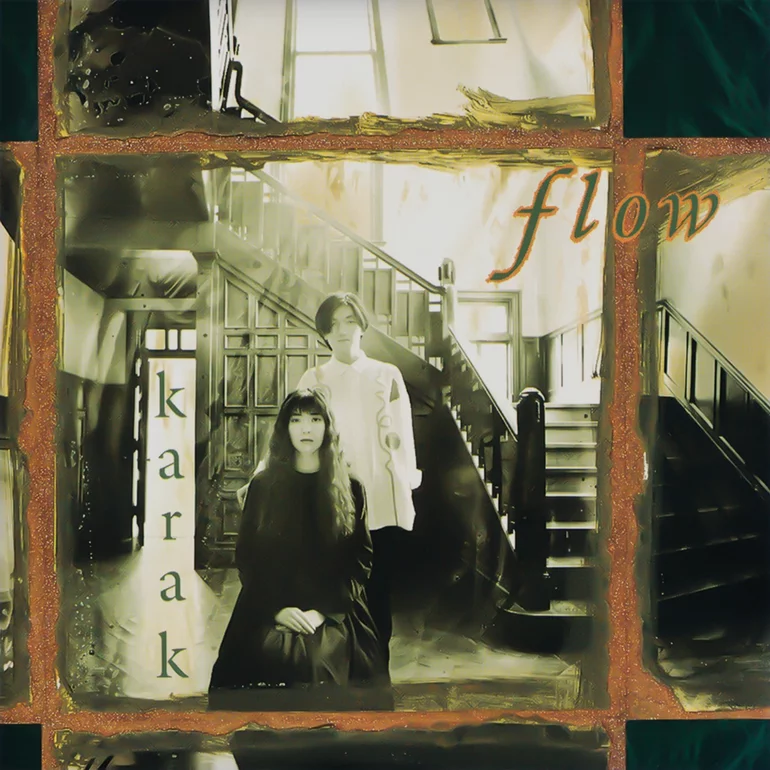It’s pretty hard to write about Fukushima’s Karak without not waxing a bit nostalgic. Over the course of two records – Silent Days (サイレント) and Flow (フロウ) – all the music they created hovers around a certain mood and a certain period. For me, their tracks like “明日ヲ見ル丘” and “ゆめのスウプ” instantly conjure up all these autumnal feelings. I can only imagine that’s what I think the duo of Hisaaki Hogari and Koko Komine wanted to accomplish through their music. Married to a certain feeling, and exploring just where you can take such an influence, is the reason I remain a big fan of that small door they went through.
It was in Fukushima where Koko Komine befriended Hisaaki Hogari while performing in various highschool New Wave bands. Once they both headed to university in Tokyo, in 1987, they decided to form a band, inspired by the avant-pop of Kate Bush, Japan’s own Zabadak and early, pop folk pioneers, Tulip and a heavy dose of prog music. As huge fans of folk music they knew the only way they could explore it was by creating it together. So, they’d take the name Koko Komine and Karak, with karak coming as a portmanteau of the Japanese word for chocolate cake, and create their first songs (and shortly drop out of college).

Hisaaki Hogari came in with musical pedigree. Although they wouldn’t officially record their first album until 1991, Hisaaki had already contributed music to compilation albums by forward-thinking “future pop” labels like Fairland and been a key cog in interesting albums by Akira Inoue, Seishiro Kusunose, and PSY-S. As a guitarist and arranger, it wouldn’t be until he could freely create with Koko that he was able to show off his impressive music (influenced by Western folk tradition and his unique experimental sensibility).
Koko Komine’s strengths came through in her lyricism and songwriting chops. Japanese literature was the focus of her educational career. On tape, she translated the multilayered storytelling of her homeland’s tradition and its ties to fantasy and brought it into music that felt of a lineage that stretched to English folk-rock and the ever-evolving prog that falls out of favor every so often. Her impressive background as a keyboardist and her deep vocal training made her a perfect frontwoman for the kind of futuristic, dramatic avant-folk or neofolk that would come to be under Karak.
King Records originally signed Koko Komine not as a singer but as part of a modeling agency. Thankfully, for us, Koko was able to flip the script and push for a music career, ushering her old friend, Hisaaki, as a must needed piece to create her “solo” work. Once the contract was signed, they for all intents and purposes became a duo with Hisaaki fleshing out Koko’s demos with increasingly complex arrangements that carved out its own niche in Japan’s bubbling indie alternative scene. Intriguingly, on their debut, 1991’s Silent Days (サイレント), Yoko Kanno would play a not-so-quiet role as keyboardist, contributing to a lot of the stately, floating, atmosphere that made Karak, Karak.
Gorgeous highlights from Silent Days (サイレント) like “明日ヲ見ル丘” and “Throw To Me” work wonders in updating a folk tradition into a contemporary sound. Others like “雨の日のPiano” and “傷つけぬよう 離れぬように” tip their hat a bit too furiously at the feet of obvious influence: Kate Bush (and sounding too much like a lesser 蟻プロジェクト/Ali Project). I think it’s on their sophomore release, 1992’s Flow (カラク) when, for lack of a better word, their own unique ideas really start to flow.
Where their debut was a bit lightweight and fey, Flow (カラク) has a certain haunting and powerful atmosphere. In it, Koko Komine never sounded quite as spirited and in full control of her range. Likewise, Hisaaki’s soundscapes went more acoustic yet sounded more expressive and experimental with less (somehow). On songs like “Visions Of Highland” we can finally see the comparisons to the Cocteau Twins. You hear “ゆめのスウプ” play with the floating atmospherics of the ‘80s in a way that works to their proggy neofolk stylings. Hovering outside of their influence, Karak found the crack to find their own way.
On Flow (カラク) you get the light Steve Reich-isms of “海の声” set in the Scottish highlands. Sparse songs like “海辺のまちで” elegiac torch ballads of bands reconfigure Min’yō tradition as wonderfully grafted-on neofolk hybrids of their own stripe. “Keep A Light Burning” finds them successfully rolling in the modal jazz of groups like Killing Time into their own panoramic neofolk.
Other songs like “僕の箱庭” belong to that special sound that fellow avant-pop peers like Mio Fou expressed. What’s there to say about “夜を包んで”? Hearing it reminds me of that regal music that another Fukushima native, Takemi Hasegawa, once released into the world. In a world of twee fantasy, Karak’s kaleidoscopic music crossed the looking glass with just so much ease.
